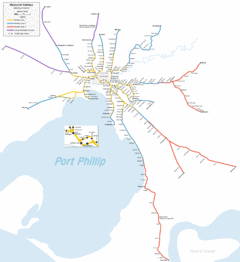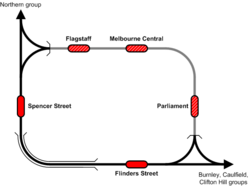City Loop, Melbourne
| Melbourne's railway lines | ||
|---|---|---|

| ||
| City Loop | ||
| Caulfield group | ||
| Frankston line | ||
| Pakenham line | ||
| Sandringham line | ||
| Cranbourne line | ||
| Northern group | ||
| Upfield line | ||
| Werribee line | ||
| Broadmeadows line | ||
| Sydenham line | ||
| Williamstown line | ||
| Flemington Racecourse line | ||
| Burnley group | ||
| Lilydale line | ||
| Glen Waverley line | ||
| Belgrave line | ||
| Alamein line | ||
| Clifton Hill group | ||
| Hurstbridge line | ||
| Epping line | ||
| Greater-metropolitan | ||
| Stony Point line | ||
| Melton line | ||
| Sunbury line | ||
| Craigieburn line |
| Melbourne's public transport | |||
|---|---|---|---|
| Metlink | Metcard | myki | |
| Modes of Transport | |||
| Trains | Trams | Buses | |
| Transport Routes | |||
| Railway stations | Tram routes | Bus routes | |
| Operating Companies | |||
| V/Line | Connex Melbourne | Yarra Trams | |
The City Loop (properly called the Melbourne Underground Rail Loop or MURL) is a mostly-underground, partly surface-level and partly elevated railway around the central business district of Melbourne, Victoria, Australia. It includes the city's two largest (both above-ground) stations: Flinders Street and Southern Cross (formerly Spencer Street); and three underground stations: Flagstaff, Melbourne Central (formerly Museum), and Parliament.
Melbourne's 16 radial suburban railway lines feed into the Loop at its northwestern and southeastern corners. The underground section of the Loop follows La Trobe and Spring Streets along the northern and eastern edges of the CBD's street grid.
Photography was banned in the Loop in 2004, much to the disappointment of railway enthusiasts.
Contents
Problems and solutions
Prior to the construction of the Loop, Flinders Street and Southern Cross (then Spencer Street) stations were connected only by a viaduct beside the Yarra River. Flinders Street, the suburban terminus, had become seriously congested by the 1970s, with a throughput of only ten trains per platform per hour (roughly 1,700 trains a day); not enough to satisfy the city's growing needs. Many trains terminated here, taking up valuable track space and time before heading back in the direction from which they had come.
Several plans had been proposed over the preceding decades to alleviate the bottleneck. The one that was built was a circular railway allowing trains to continue past Flinders Street, turn around and return to the suburbs. It was as the solution to the platform capacity problem, allowing up to 24 trains per platform per hour in both directions (around 4,100 trains a day). The Loop would also bring train commuters directly into the northern and eastern sections of the CBD, delivering workers closer to their offices, students closer to RMIT University, and government officials directly to the Parliament buildings. Although the city's tram network already covered the CBD extensively, trams are not as efficient as trains when bringing large numbers of commuters into the city.
Construction
The Melbourne Underground Rail Loop Authority (MURLA) was created in February 1971 to oversee the construction and operation of the Loop, and the Melbourne Underground Rail Loop Act (1970) paved the way for the project to begin. Tunneling works commenced with the turning of the first sod in June 1971.
The Loop comprises four single-track tunnels on two levels, and two elevated tracks between Flinders Street and Spencer Street stations on a new viaduct beside the old one. Of the three new stations, Museum was built using the cut and cover method, while Flagstaff and Parliament were excavated using mining methods. During the excavation of Museum station, La Trobe Street and its tram tracks were temporarily relocated to the south onto the site of what is now the Melbourne Central shopping centre.
The total length of tunnels in the Loop is 12 km, 10 km of circular tunnels and 2 km of box tunnels. The four tunnels have an average length of 3.74 km, with a further kilometre of track connecting with surface tracks. Some 900,000 m3 of earth was removed and 300,000 m3 of concrete poured to form the stations and line the tunnel walls. 30,000 tons of steel reinforcement were used, with another 10,000 tonnes used temporarily during construction.
Opening
The Loop was opened gradually between 1981 and 1985. Museum station and the Burnley and Caulfield tunnels opened first, on January 25 1981. The City Circle tunnel opened with special services on December 6 1981: Clifton Hill services started using the Loop on October 31 1982. Parliament station opened on January 22 1983, the Northern tunnel on January 7 1985 (January 14 1985 with limited services) and Flagstaff station on May 27 1985.
Queen Elizabeth II toured Museum station during her 1981 tour of Australia. Two short documentary films, Loop and Action Loop, were commissioned by the MURLA to advertise the new railway to Melburnians, as well as abroad. (These videos can be downloaded from the Department of Infrastructure). A third film was planned, but never shot.
Future expansion
The Victorian Government has intimated that the Loop could be expanded with the addition of a further two tunnels on a third level. The Loop (and particular tunnels especially) is slowly approaching capacity, but any extension would not occur for at least 20 to 30 years at current service levels. Other more nebulous schemes have been suggested that would see a new linear railway running under the city centre from north to south, following the line of Swanston Street. Neither plan is being considered at present, as government funding for public transport improvements, including those that it advocates, is rarely forthcoming.
Suggestions have been made to include Melbourne University, with adjacent Royal Melbourne Hospital, Royal Women's Hospital and nearby Royal Children's Hospital, on the Loop. This proposal was considered at the time of Loop construction, but was ruled out for cost reasons. With the increase in passenger numbers since then, the trams currently servicing this area suffer severe overcrowding at peak times and the call for a Loop expansion has been raised again [1].
Services and direction of travel
All suburban trains serve Flinders Street, some having travelled through the Loop first, some travelling directly to Flinders Street then through the Loop, and a small number reversing at Flinders Street (as many trains did before the Loop was built).
There was a special City Circle service, which circled continuously around the Loop to provide cross-CBD travel; this has been discontinued, with trams providing the alternative. As a result, if you wish to travel from say Parliament to Flinders Street by train at certain times of day, you have to change trains at a third station even though they are adjacent.
The direction of travel changes in each tunnel according to the time of day and day of week, as shown in the table below. Each suburban line belongs to one of four groups, each group running through one tunnel. The direction change occurs between approximately 12.30 and 1.00 pm, during which time no trains run through the Loop.
| Burnley group | Caulfield group | Clifton Hill group / City Circle |
Northern group | |
| Weekday mornings | All loop trains run via the Loop to Flinders Street | |||
| Anti-clockwise | Anti-clockwise | Anti-clockwise | Clockwise | |
| Weekday afternoons | All loop trains run via the Loop after departing Flinders Street | |||
| Clockwise | Clockwise | Clockwise | Anti-clockwise | |
| Weekends | All loop trains except Caulfield group train run via the Loop after departing Flinders Street | |||
| Clockwise | Anti-clockwise | Clockwise | Anti-clockwise | |
- Note: It is likely that in the future the Clifton Hill Loop will run clockwise all day to avoid the flat junction at Jolimont and permit increased service frequency.
External links and maps
- Metlink - official website of Melbourne's public transport
- Publicity leaflets circa 1970 (the source of much of this article)
- Zen and the City Loop (a more detailed explanation of the five train direction configurations)
- Department of Infrastructure City Loop history webpage
- Victorian Department of Infrastructure- Public Transport subcategory

